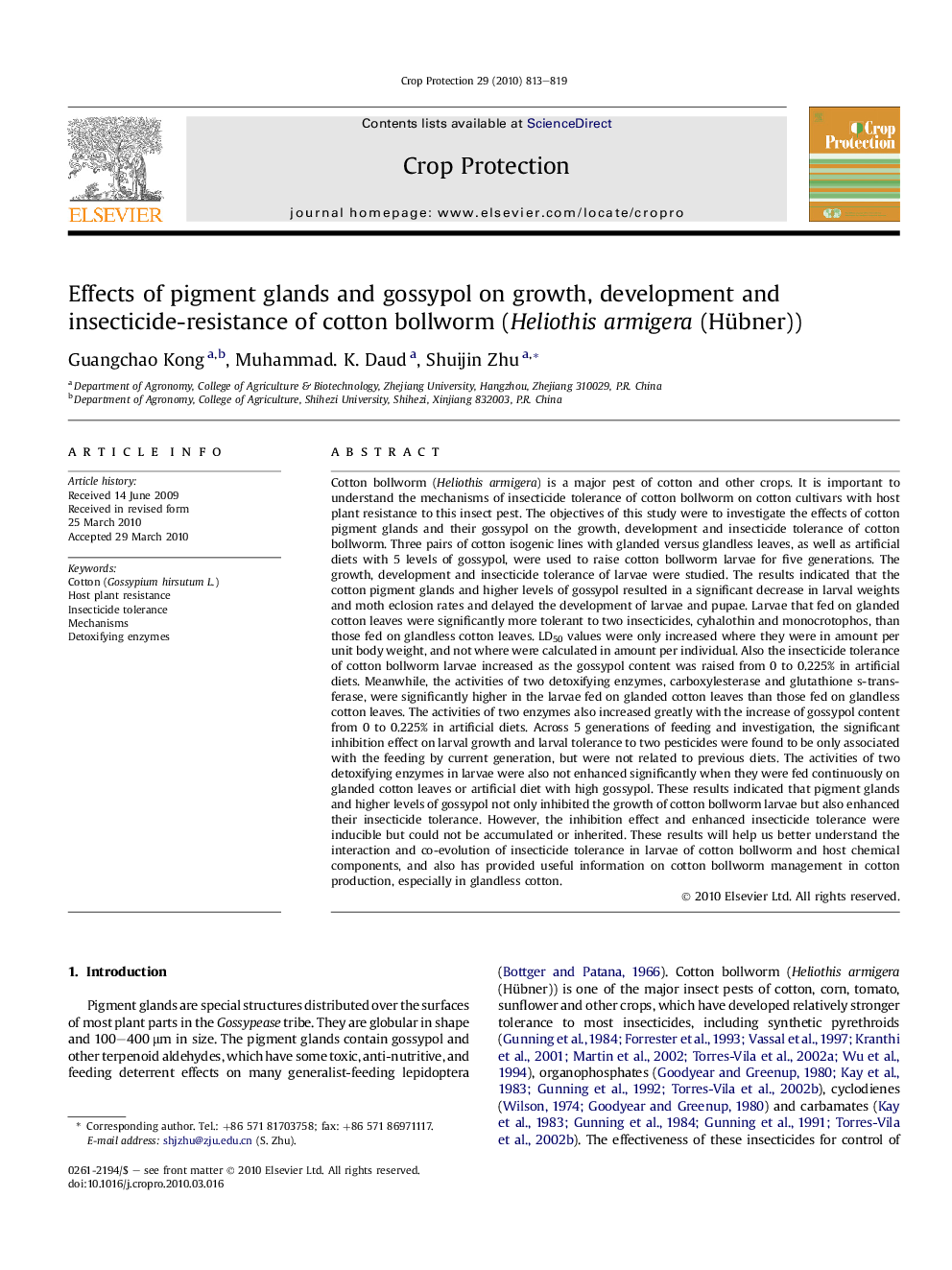| کد مقاله | کد نشریه | سال انتشار | مقاله انگلیسی | نسخه تمام متن |
|---|---|---|---|---|
| 4506734 | 1321327 | 2010 | 7 صفحه PDF | دانلود رایگان |
عنوان انگلیسی مقاله ISI
Effects of pigment glands and gossypol on growth, development and insecticide-resistance of cotton bollworm (Heliothis armigera (Hübner))
دانلود مقاله + سفارش ترجمه
دانلود مقاله ISI انگلیسی
رایگان برای ایرانیان
کلمات کلیدی
موضوعات مرتبط
علوم زیستی و بیوفناوری
علوم کشاورزی و بیولوژیک
علوم زراعت و اصلاح نباتات
پیش نمایش صفحه اول مقاله

چکیده انگلیسی
Cotton bollworm (Heliothis armigera) is a major pest of cotton and other crops. It is important to understand the mechanisms of insecticide tolerance of cotton bollworm on cotton cultivars with host plant resistance to this insect pest. The objectives of this study were to investigate the effects of cotton pigment glands and their gossypol on the growth, development and insecticide tolerance of cotton bollworm. Three pairs of cotton isogenic lines with glanded versus glandless leaves, as well as artificial diets with 5 levels of gossypol, were used to raise cotton bollworm larvae for five generations. The growth, development and insecticide tolerance of larvae were studied. The results indicated that the cotton pigment glands and higher levels of gossypol resulted in a significant decrease in larval weights and moth eclosion rates and delayed the development of larvae and pupae. Larvae that fed on glanded cotton leaves were significantly more tolerant to two insecticides, cyhalothin and monocrotophos, than those fed on glandless cotton leaves. LD50 values were only increased where they were in amount per unit body weight, and not where were calculated in amount per individual. Also the insecticide tolerance of cotton bollworm larvae increased as the gossypol content was raised from 0 to 0.225% in artificial diets. Meanwhile, the activities of two detoxifying enzymes, carboxylesterase and glutathione s-transferase, were significantly higher in the larvae fed on glanded cotton leaves than those fed on glandless cotton leaves. The activities of two enzymes also increased greatly with the increase of gossypol content from 0 to 0.225% in artificial diets. Across 5 generations of feeding and investigation, the significant inhibition effect on larval growth and larval tolerance to two pesticides were found to be only associated with the feeding by current generation, but were not related to previous diets. The activities of two detoxifying enzymes in larvae were also not enhanced significantly when they were fed continuously on glanded cotton leaves or artificial diet with high gossypol. These results indicated that pigment glands and higher levels of gossypol not only inhibited the growth of cotton bollworm larvae but also enhanced their insecticide tolerance. However, the inhibition effect and enhanced insecticide tolerance were inducible but could not be accumulated or inherited. These results will help us better understand the interaction and co-evolution of insecticide tolerance in larvae of cotton bollworm and host chemical components, and also has provided useful information on cotton bollworm management in cotton production, especially in glandless cotton.
ناشر
Database: Elsevier - ScienceDirect (ساینس دایرکت)
Journal: Crop Protection - Volume 29, Issue 8, August 2010, Pages 813-819
Journal: Crop Protection - Volume 29, Issue 8, August 2010, Pages 813-819
نویسندگان
Guangchao Kong, Muhammad. K. Daud, Shuijin Zhu,